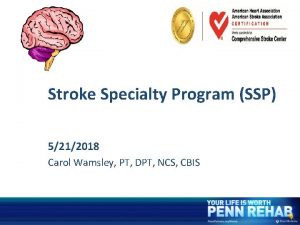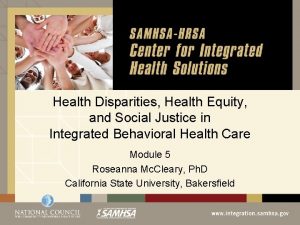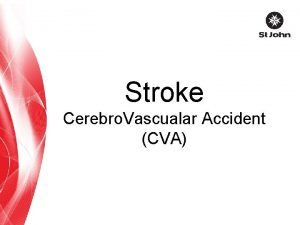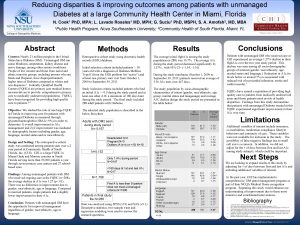Disparities Among Stroke Patients Recovery Ella Smith Why











- Slides: 11

Disparities Among Stroke Patient’s Recovery Ella Smith

Why strokes? ◦ Strokes are one of the leading causes of disability ◦ Fifth leading cause of death in the United States ◦ About 795, 000 people suffer from a stroke every year ◦ 140, 000 people die from a stroke every year ◦ Strokes can cause amnesia, aphasia, paralysis or coma

What is a stroke? ◦ A stroke is described as “a sudden-onset cerebrovascular disorder that causes brain damage” (Pinel & Barnes, 2018). ◦ Cerebral ischemia ◦ 87% of strokes ◦ Cerebral hemorrhage ◦ 13% of strokes

What is the importance of rehabilitation? ◦ Rehabilitation is “critical to many stroke survivors' regaining the functional skills necessary to return to premorbid levels of independence. Rehabilitation programs are designed to reduce functional disability, thereby improving patient satisfaction and reducing the economic burden associated with long-term stroke-related disability” (Ellis et al. , 2015). ◦ Acute care ◦ Post-acute care ◦ Inpatient ◦ Outpatient Occupational Therapy Physical Therapy Speech Language Pathology

Stroke Disparities ◦ Ethnicity, socioeconomic status, gender, age, amount of rehabilitation ◦ Functional Measure of Independence (FIM) ◦ Complete dependence (level 1) ◦ Complete independence (level 7) ◦ Barthel Index ◦ Rivermead Motor Assessment ◦ Asks questions regarding, “self-care, sphincter control, transfer capability, locomotion, communication, and social cognition” (Perrin et al. , 2010).

Ethnicity ◦ In one study, the Functional Independence Measure determined that Latino/Puerto-Rican individuals had an overall lower quality of life with more dependence than the quality of life for Black and White individuals ◦ Blacks experienced higher levels of impairment at stroke onset than did whites ◦ Blacks reported lower levels of functional independence at 1 -year poststroke onset ◦ Blacks reported lower levels of functional independence and driving independence

Ethnicity ◦ African Americans who had a stroke were twice as likely as Whites to have a second stroke ◦ Latinos were 2. 6 times as likely to have a second stroke than Whites ◦ More Occupational Therapy for Whites ◦ Care is altered depending on family structure, cultural norms, living condition and mental state (both caregiver and patient) ◦ Latino culture: collectivist ◦ White culture: individualism and self-reliance ◦ African American culture: somewhere in the middle

Socioeconomic Status (SES) ◦ Patients with lower SES tend to receive different diagnostics than those with higher SES ◦ High SES patients can afford more care and treatment ◦ Low SES patients tend to be less educated ◦ “During the inpatient rehabilitation period, a higher educational level was significantly associated with better motor and functional recovery” (Putman et al. , 2007). ◦ Barthel Index and Rivermead Motor Assessment scores did not improve for patients with lower education

Gender, Age and Rehabilitation Stay ◦ Strokes have greater impact on women than men ◦ Barthel Index measured that women have more physical impairments and limitations on activities of daily living ◦ Strokes are more common in older age ◦ Functional recovery of older patients occurs at a slower rate ◦ Older patients stay in rehabilitation facilities longer ◦ Less endurance during therapy sessions, bodies have more limitations to begin with fostering a longer stay o The older the patient is, the longer they will stay in rehabilitation and the more intense the care will be

References ◦ Arrich, J. , Mu llner, M. , Lalouschek, W. , Greisenegger, S. , Crevenna, R. , & Herkner, H. (2008). Influence of socioeconomic status and gender on stroke treatment and diagnostics. Stroke, 39(7), 2066 -2072. ◦ Bagg, S. , Pombo, A. P. , & Hopman, W. (2002). Effect of age on functional outcomes after stroke rehabilitation. Stroke, 33(1), 179 -185. ◦ Ellis, C. , Boan, A. D. , Turan, T. N. , Ozark, S. , Bachman, D. , & Lackland, D. T. (2015). Racial differences in poststroke rehabilitation utilization and functional outcomes. Archives of physical medicine and rehabilitation, 96(1), 84 -90. ◦ Gregory, P. C. , Han, E. , Morozova, O. , & Kuhlemeier, K. V. (2006). Do racial disparities exist in access to inpatient stroke rehabilitation in the state of Maryland? . American journal of physical medicine & rehabilitation, 85(10), 814 -819. ◦ Mc. Naughton, H. , Feigin, V. , Kerse, N. , Barber, P. A. , Weatherall, M. , Bennett, D. , . . . & Anderson, C. (2011). Ethnicity and functional outcome after stroke. Stroke, 42(4), 960 -964. ◦ Ottenbacher, K. J. , Campbell, J. , Kuo, Y. F. , Deutsch, A. , Ostir, G. V. , & Granger, C. V. (2008). Racial and ethnic differences in postacute rehabilitation outcomes after stroke in the United States. Stroke, 39(5), 1514 -1519. ◦ Perrin, P. B. , Heesacker, M. , Uthe, C. E. , & Rittman, M. R. (2010). Caregiver mental health and racial/ethnic disparities in stroke: Implications for culturally sensitive interventions. Rehabilitation Psychology, 55(4), 372. ◦ Pinel, J. P. J. , & Barnes, S. J. (2018). Biopsychology (10 th ed. ). Harlow: Pearson. ◦ Putman, K. , De Wit, L. , Schoonacker, M. , Baert, I. , Beyens, H. , Brinkmann, N. , . . . & Jenni, W. (2007). Effect of socioeconomic status on functional and motor recovery after stroke: a European multicentre study. Journal of Neurology, Neurosurgery & Psychiatry, 78(6), 593 -599. ◦ Reeves, M. J. , Bushnell, C. D. , Howard, G. , Gargano, J. W. , Duncan, P. W. , Lynch, G. , . . . & Lisabeth, L. (2008). Sex differences in stroke: epidemiology, clinical presentation, medical care, and outcomes. The Lancet Neurology, 7(10), 915 -926.

Image References ◦ https: //sites. google. com/site/movementincontext 6/the-assessments/functional-independencemeasure ◦ https: //www. cdc. gov/stroke/types_of_stroke. htm
 Andreas leischker
Andreas leischker Nursing interventions for stroke patients
Nursing interventions for stroke patients Anterior stroke vs posterior stroke
Anterior stroke vs posterior stroke Why why why why
Why why why why Stroke recovery stages
Stroke recovery stages Guidelines for adult stroke rehabilitation and recovery
Guidelines for adult stroke rehabilitation and recovery 30-30-30 model of health disparities
30-30-30 model of health disparities Health disparities meaning
Health disparities meaning Health disparities meaning
Health disparities meaning 30-30-30 model of health disparities
30-30-30 model of health disparities Chapter 3 health wellness and health disparities
Chapter 3 health wellness and health disparities Maternal and infant health disparities
Maternal and infant health disparities





















